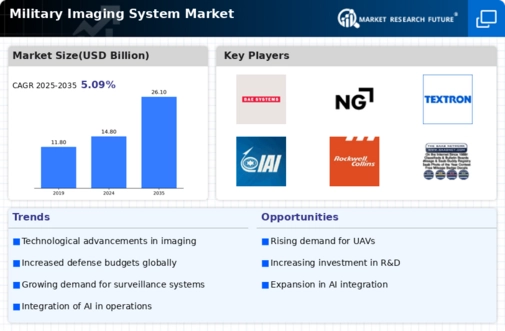Top Industry Leaders in the Military Imaging System Market

Strategies Adopted: In the fiercely competitive Military Imaging System market, key players deploy strategic approaches to maintain a competitive edge. Continuous investment in research and development (R&D) is crucial, enabling companies to introduce next-generation imaging systems with enhanced resolution, range, and multi-spectral capabilities. Strategic collaborations with defense agencies, international partnerships, and alliances facilitate technology transfer and ensure the development of specialized imaging systems tailored to specific military operational needs. Global market expansion is achieved through participation in defense contracts, international sales, and establishing production facilities in key regions, ensuring a broad market reach and allowing companies to address the diverse requirements of defense forces worldwide.
Competitive Landscape of Military Imaging System Market
- FLIR Systems Inc. (US)
- Teledyne Technologies Inc. (US)
- Thales Group (France)
- L3 Technologies Inc. (US)
- Lockheed Martin Corporation (US)
- BAE Systems (US)
- Raytheon Company (US)
- Harris Corporation (US)
- General Dynamics Mission Systems Inc (US)
- Leonardo DRS (US)
Factors for Market Share Analysis: Market share analysis in the Military Imaging System market involves considering various factors crucial to a company's competitive standing. Technical capabilities, such as offering a comprehensive range of imaging systems covering various modalities, from thermal infrared to night vision, play a pivotal role. Companies providing adaptable and modular imaging solutions capable of addressing diverse military applications, including surveillance, targeting, and reconnaissance, are better positioned to capture a larger market share. Compliance with stringent military standards, image quality, and integration of advanced technologies such as artificial intelligence contribute significantly to market share dynamics. Additionally, factors like size, weight, and power (SWaP) considerations, along with cost-effectiveness, influence a company's market share by enhancing the overall value proposition for defense customers.
New and Emerging Companies: While established players dominate the market, new and emerging companies are making significant strides in the Military Imaging System sector. Companies like Roketsan and HGH Infrared Systems are gaining recognition for their specialized imaging systems, often focusing on innovative applications, modularity, and integration with broader defense systems. Emerging companies often bring agility and a fresh perspective to the market, introducing novel approaches and technologies that address the evolving needs of modern military operations.
Industry News: Recent industry news in the Military Imaging System market underscores ongoing developments and trends shaping the sector. Innovations in hyperspectral imaging, wide-area surveillance capabilities, and advancements in image processing algorithms are gaining prominence. News often covers the integration of imaging systems with unmanned aerial vehicles (UAVs) for enhanced situational awareness and reconnaissance. Additionally, developments in compact, lightweight imaging solutions for dismounted soldiers and advancements in low-light imaging technologies highlight the industry's commitment to staying ahead of emerging threats and technological advancements. Industry news reflects the dynamic nature of the Military Imaging System market, with continuous efforts to improve imaging capabilities, versatility, and overall military operational effectiveness.
Current Company Investment Trends: Investment trends in the Military Imaging System market underscore a commitment to technological innovation, miniaturization, and global reach. Companies are allocating substantial resources to R&D initiatives focused on advanced sensor technologies, artificial intelligence integration, and reducing SWaP requirements. Investments in cybersecurity measures for secure image transmission and storage, as well as the development of multi-sensor fusion technologies, align with the defense industry's broader goals. Strategic acquisitions of technology startups, partnerships with research institutions, and collaborations with international defense contractors contribute to a comprehensive approach, ensuring a continuous stream of cutting-edge solutions and maintaining a competitive stance in the market.
Overall Competitive Scenario: The overall competitive scenario in the Military Imaging System market reflects a balance between established industry leaders and emerging companies that bring innovation and flexibility to the sector. Established defense contractors and imaging technology providers leverage their extensive experience, global reach, and comprehensive imaging system portfolios to set industry standards. Simultaneously, emerging companies contribute to the diversification of Military Imaging System solutions, often focusing on specific applications or introducing disruptive technologies. The industry's response to evolving military requirements, technological advancements, and the integration of advanced features into imaging systems highlights the adaptability and resilience of Military Imaging System providers. As defense forces globally seek more advanced and versatile imaging solutions, the Military Imaging System market is poised for continued evolution. The emphasis on technological advancements, strategic collaborations, and meeting the dynamic needs of modern military operations positions this market as a critical enabler for military situational awareness, target identification, and overall operational success.
Recent Development:Top of Form
Leonardo DRS (US): Leonardo DRS has been awarded a $144 million contract to supply the US Army with its Vehicle Mounted Modular Imaging System (VMMIS). The VMMIS is a long-range, high-resolution electro-optical/infrared (EO/IR) imaging system that can be mounted on a variety of vehicles. It provides soldiers with the ability to see in all weather conditions, day or night, and at long distances.
Elbit Systems (Israel): Elbit Systems has unveiled its new Skylark 3LE mini-tactical unmanned aerial vehicle (UAV). The Skylark 3LE is equipped with an advanced EO/IR payload that provides real-time intelligence, surveillance, and reconnaissance (ISR) capabilities. The UAV has a range of up to 40 km and can stay airborne for up to 4 hours.
Thales Group (France): Thales Group has developed a new radar system called Ground Master 400. The Ground Master 400 is a 3D multi-function radar that can track multiple targets simultaneously, in all weather conditions. It is designed for air and missile defense applications.


